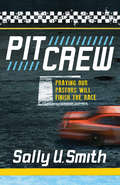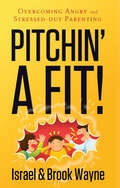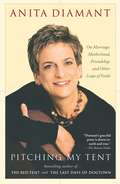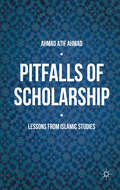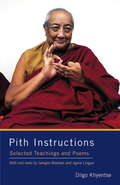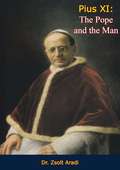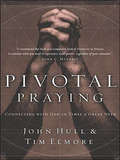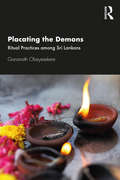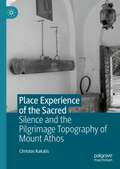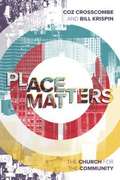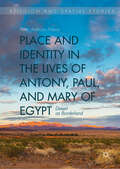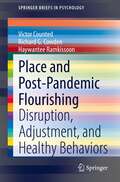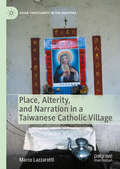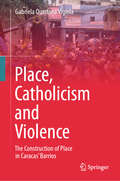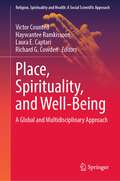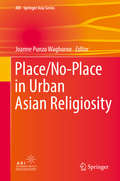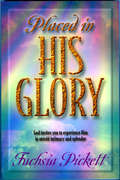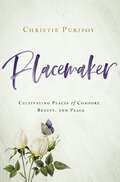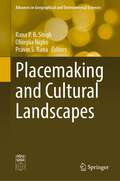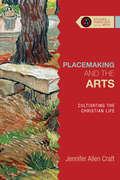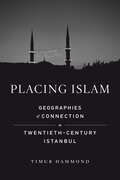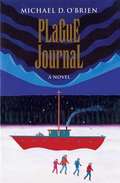- Table View
- List View
Pit Crew: Praying Our Pastors Will Finish the Race
by Sally U. SmithThis high octane book will leave you as passionate about praying for your pastor as NASCAR fans are when their favorite driver pulls into the winner’s circle.
Pitch Black: Color Me Lost (TrueColors #4)
by Melody CarlsonIf Morgan thought her life was tough before -- what with a drug-addicted, klepto brother and a cradle-robbing mother -- it just got worse: Her friend Jason took his own life. Morgan copes -- or tries to -- by attempting to piece together vague clues that might explain Jason's suicide. Making matters worse, she can't help but feel responsible somehow. Sometimes she thinks maybe Jason had the right idea all along.
Pitchin' A Fit!: Overcoming Angry and Stressed-Out Parenting
by Israel Wayne Brook WayneParenting comes with stresses that can make the most laid-back among us feel irritable, frustrated, and angry. Even parents who sincerely love their children sometimes use the wrong methods of anger and frustration in an attempt to control their children. But angry parenting doesn't just weaken relationships between parents and their children; it can, over time, destroy them. Few parents set out to become yelling meanies who no longer enjoy their children. Yet many feel stuck, unable to pull themselves out of their ugly habits. This book: Provides practical and biblical solutions to get to the other side of the issue Gives hope and freedom from the tyranny of stressed-out and angry parenting Offers solutions that are ideal for any family. If anger is in your home -- even in small ways -- this book is for you. It is time to replace that anger with something more powerful: patience and peace. Israel and Brook share candidly from their experience as parents.
Pitching My Tent: On Marriage, Motherhood, Friendship, and Other Leaps of Faith
by Anita DiamantFrom the bestselling author of The Red Tent and Good Harbor, a collection of intimate, autobiographical reflections on the milestones, revelations, and balancing acts of life as a wife, mother, friend, and member of a religious community.Before The Red Tent won her international literary acclaim, Anita Diamant was a columnist in Boston. Over the course of twenty years, she wrote essays that reflected the shape and evolution of her life, as well as the trends of her generation. In the end, her musings about love and marriage, birth and death, nature versus nurture, politics and religion—and everything from female friendships to quitting smoking—have created a public diary of the progress of her life that resonated deeply with her readers. Now, Pitching My Tent collects the finest columns of a writer who is a reporter by training and a storyteller by heart, all revised and enriched with new material. Personal, inspiring, and often funny, Pitching My Tent displays the warmth, humor, and wisdom that Diamant's legions of fans have come to cherish.
Pitfalls of Scholarship: Lessons From Islamic Studies
by Ahmad Atif AhmadPitfalls of Scholarship offers an array of reflections on higher education, its entanglements with humanity's pursuit of natural and social knowledge, and the impact national environments have upon it. This book considers the humanities, vocational, and scientific/technological sides of the university from the vantage-point of an Islamic studies scholar in twenty-first century American academia. Four discussions and a personal note make up the parts of these pages. The first discussion sets the stage with a description of the irregularities of our age of late modernity and the limits of scholarship in it. The second focuses on clashes of personal and academic knowledge with social assumptions and convictions. Guiding the discussion is an unlikely narrative from an old era where academic freedom did not exist. The third discussion points to the surprisingly negative impacts of obsession with research methods in the modern academy. "Scholarships of negation" are identified as the main illness of the age, next to popular exaggerations of the value of standard assumptions and excellent academic institutions. The fourth and final section deals with modern education's aspiration toward acquiring democratic quality, and the implications of further democratization of education.
Pith Instructions: Selected Teachings and Poems
by Jigme Lingpa Jamgon Mipham Dilgo Khyentse RinpocheThis small collection of commentaries and verse by Dilgo Khyentse Rinpoche, one of the greatest spiritual leaders of the twentieth century, contains exposition on different stages of the Buddhist path from the perspective of meditative experience and actually putting the teachings into practice. Originally given orally to Western students, the texts afford a rare glimpse into the direct transmissions of a master teacher. The commentaries are on ? * The Wheel of Investigation and Meditation That Thoroughly Purifies Mental Activity by Jamgön Mipham * The Lamp That Dispels Darkness by Jamgön Mipham * A Wondrous Ocean of Advice for the Practice of Retreat in Solitude by Jigme Lingpa.These, along with the five selected poems in the final section, provide an introduction to the wisdom and compassion of Khyentse Rinpoche.
Pius XI: The Pope and the Man
by Zsolt AradiAn appealing and readable life of one of the greatest men of the early twentieth century: Pius XI as he appeared on the stage of history, and Pius the man as his closest friends knew and loved him.Pope Pius XI (born Ambrogio Damiano Achille Ratti: 31 May 1857 - 10 February 1939) reigned as Pope from 6 February 1922 to his death in 1939. He was the first sovereign of Vatican City from its creation as an independent state on 11 February 1929. He took as his papal motto, “Pax Christi in Regno Christi,” translated “The Peace of Christ in the Kingdom of Christ.”Pius XI issued numerous encyclicals, and to establish or maintain the position of the Catholic Church, he concluded a record number of concordats, including the Reichskonkordat with Germany. During his pontificate, the longstanding hostility with the Italian government over the status of the papacy and the Church in Italy was successfully resolved in the Lateran Treaty of 1929.He canonized important saints, including Thomas More, Petrus Canisius, Konrad von Parzham, Andrew Bobola and Don Bosco. He beatified and canonized Thérèse de Lisieux, for whom he held special reverence, and gave equivalent canonization to Albertus Magnus, naming him a Doctor of the Church due to the spiritual power of his writings.Pius XI created the feast of Christ the King in response to anti-clericalism. He took a strong interest in fostering the participation of lay people throughout the Catholic Church, especially in the Catholic Action movement. The end of his pontificate was dominated by speaking out against Hitler and Mussolini and defending the Catholic Church from intrusions into Catholic life and education.He died on 10 February 1939 in the Apostolic Palace and is buried in the Papal Grotto of Saint Peter’s Basilica.
Pivotal Praying
by John HullWe all face critical forks in the road-marriage, the death of a loved one, the birth of a child, or a personal health crisis. How are we to pray at these junctures? Perhaps our instinct is to send up a quick "911" prayer, but authors John Hull and Tim Elmore demonstrate how by praying the right prayer at the right time, we can see the incredible impact of what God can do.Scripture offers countless examples of men and women who prayed strategically and saw results. Remember Solomon's prayer for wisdom? He received it-and wealth beyond his imagination as well. And how about Hannah's desire for a child? God honored her prayer; her son Samuel became the greatest judge in Israel's history. Pivotal Praying uses these examples and others to illustrate the power of effective-and ineffective-praying. For those seeking to enlarge their prayer vision and alter their circumstances for God's glory, Pivotal Praying is an ideal resource.
Pièce de Résistance: A Novel
by Sandra ByrdHaving earned her chef’s hat, Lexi Stuart bidsau revoirto her glamorous and deliciously satisfying pastry mentorship outside of Paris and returns to her hometown of Seattle, Washington. There, she finds life unexpectedly complicated. She’s put in charge of a high-end catering bakery calledBijoux,which should be her dream job, but there’s a catch: She has to make this lavish bakery into a successful business in just a few, short months, which will require more than her ability to make an amazing wedding cake. In over her head and at a loss for creative marketing ideas, Lexi isn’t sure what the recipe for success needs to be. Stir in a complicated relationship with her FrenchbeauPhilippe and his daughter, Celine, then add a dash of romance with down-to-earth lawyer Dan, and life suddenly contains moreooh la lathan Lexi can handle. With the fate of her career and her love life hanging by a thread, the phrase “piece of cake” has never been more daunting. Lexi learns that she must trust the dreams in her heart and the God who put them there.
Placating the Demons: Ritual Practices among Sri Lankans
by Gananath ObeyesekereThis book critically examines dominant ceremonial practices in Sri Lanka. It presents key ideas and symbolic systems that exist to this day, in similar shapes or in different guises. It looks at issues such as misfortunes caused by demons (yaksa dosa), an important ceremonial practice known as the puna-yāgaya, ideas pertaining to spirit possession, trance, and mediums. It also deals with classical Ayurvedic theories of disease, urban ceremonial practices such as cases of the apotheoses from demon to divinity, as well as multiple forms of Buddhist ceremonial practices that are part of the Sri Lankan consciousness and have found their way into public cultural performances in Sri Lanka. As a comprehensive volume on ceremonial practices in Sri Lanka, this work will be useful for scholars and researchers in cultural studies, sociology, social-anthropology, and particularly those interested in myths and rituals in South Asia.
Place Experience of the Sacred: Silence and the Pilgrimage Topography of Mount Athos
by Christos KakalisThis book explores the topography of Mount Athos, emphasizing the significance of silence and communal ritual in its understanding. Mount Athos, a mountainous peninsula in northern Greece, is a valuable case study of sacred topography, as it is one of the world’s largest monastic communities and an important pilgrimage destination. Its phenomenological examination highlights the importance of embodiment in the experience of religious places. Combining interdisciplinary insights from architectural theory, philosophy, theology and anthropology with archival and ethnographic materials, the book brings a fresh contribution to both Athonite studies and scholarship on sacred space. By focusing on the interrelation between silence and communal ritual, it offers an alternative to the traditional art historical, objectifying approaches. It reintroduces the phenomenological understanding of place, investigating also how this is expressed through a number of narratives, such as travel literature, maps and diaries.
Place Matters: The Church for the Community
by Bill Krispin Coz CrosscombeMany local neighborhoods today lack an incarnational witness to the transforming gospel of Jesus. Place Matters challenges readers to combat this by studying the "what," "why" and "how" of the church's role in its local community. With biblical exposition, strategic principles and true stories, Bill Krispin and Coz Crosscombe encourage churches to engage their surrounding communities with the gospel.
Place and Identity in the Lives of Antony, Paul, and Mary of Egypt: Desert as Borderland (Religion and Spatial Studies)
by Peter Anthony MenaIn this book, Peter Anthony Mena looks closely at descriptions of space in ancient Christian hagiographies and considers how the desert relates to constructions of subjectivity. By reading three pivotal ancient hagiographies—the Life of Antony, the Life of Paul the Hermit, and the Life of Mary of Egypt—in conjunction with Gloria Anzaldúa’s ideas about the US/Mexican borderlands/la frontera, Mena shows readers how descriptions of the desert in these texts are replete with spaces and inhabitants that render the desert a borderland or frontier space in Anzaldúan terms. As a borderland space, the desert functions as a device for the creation of an emerging identity in late antiquity—the desert ascetic. Simultaneously, the space of the desert is created through the image of the saint. Literary critical, religious studies, and historical methodologies converge in this work in order to illuminate a heuristic tool for interpreting the desert in late antiquity and its importance for the development of desert asceticism. Anzaldúa’s theories help guide a reading especially attuned to the important relationship between space and subjectivity.
Place and Post-Pandemic Flourishing: Disruption, Adjustment, and Healthy Behaviors (SpringerBriefs in Psychology)
by Haywantee Ramkissoon Victor Counted Richard G. CowdenThis book rekindles the well-known connection between people and place in the context of a global pandemic. The chapters are divided into two sections. In the first section, “Place Attachment During a Pandemic,” we review the nature of the COVID-19 pandemic and the extent of its impact on place attachment and human-environment interactions. We examine how restrictions in mobility and environmental changes can have a significant psychological burden on people who are dealing with the effect of place attachment disruption that arises during a pandemic. In the second section, “Adjusting to Place Attachment Disruption During and After a Pandemic,” we focus on adaptive processes and responses that could enable people to adjust positively to place attachment disruption. We conclude the book by discussing the potential for pro-environmental behavior to promote place attachment and flourishing in the aftermath of the COVID-19 pandemic by introducing an integrative framework of place flourishing and exploring its implications for theory, research, policy, and practice.
Place, Alterity, and Narration in a Taiwanese Catholic Village (Asian Christianity in the Diaspora)
by Marco LazzarottiThis book introduces a simple idea: when we tell a story, we tell a story and at the same time create the world where this story takes place. Narration creates environments, spaces and, in a certain sense, gives symbolic meanings and values to the identities by which people interact in their daily experiences. Set in the multicultural and multireligious Taiwanese environment, this book describes the interactions, and above all the narrations, linked to a Catholic village located in the Taiwanese countryside. Catholicism in Taiwan is a minor religion (around 2% of the population), and considered a foreign and heterodox religion, something different and "other" from the Taiwanese mainstream religious environment. It is this sense of alterity that creates the stories about this place and, as a consequence, creates this place and its special identity.
Place, Catholicism and Violence: The Construction of Place in Caracas’ Barrios
by Gabriela Quintana VigiolaThis book explores the interwoven nature of place, Catholicism and violence in Caracas’ barrios. Using interdisciplinary perspectives to investigate themes of urban space, meaning as a psychosocial construct, criminal violence, and religiosity as culture, this book uncovers the underlying complexities of turning spaces into places through the built form, activities in the urban space and the meanings associated with it. Fundamental elements in the construction of place are used to understand the ways in which barrio residents conceive and construct the physicality of the private, public and religious spaces; how residents use the physical spaces of the barrios; and the psychosocial meanings residents associate with the spaces and activities. Using rich qualitative data and a case study design, the book relies on audio-visual data and interviews with organisers, residents and key participants in Petare, the largest barrio conglomeration in Caracas and Venezuela. Qualitative thematic analysis of participants’ experiences of Catholicism, violence and, ultimately, the construction of place exposes a unique argument: that meaningful urban spaces are embedded with emotions, memories, relationships, experiences and meanings, which turn them into places.
Place, Spirituality, and Well-Being: A Global and Multidisciplinary Approach (Religion, Spirituality and Health: A Social Scientific Approach #7)
by Haywantee Ramkissoon Victor Counted Richard G. Cowden Laura E. CaptariThis book synthesizes perspectives on how ‘place’ is deeply intertwined with our spirituality and well-being. Split into three sections, this book brings together contributions from global scholars across a range of disciplines to unravel how the personal, social, and cultural spheres of place shape our spiritual experiences and overall well-being. It is an essential read for those interested in enriching their knowledge of the linkages between place, spirituality, and well-being, while also providing a foundation for future research on place and its intersections with both spirituality and well-being.
Place/No-Place in Urban Asian Religiosity
by Joanne Punzo WaghorneThis book discusses Asia's rapid pace of urbanization, with a particular focus on new spaces created by and for everyday religiosity. The essays in this volume - covering topics from the global metropolises of Singapore, Bangalore, Seoul, Beijing, and Hong Kong to the regional centers of Gwalior, Pune, Jahazpur, and sites like Wudang Mountain - examine in detail the spaces created by new or changing religious organizations that range in scope from neighborhood-based to consciously global. The definition of "spatial aspects" includes direct place-making projects such as the construction of new religious buildings - temples, halls and other meeting sites, as well as less tangible religious endeavors such as the production of new "mental spaces" urged by spiritual leaders, or the shift from terra firma to the strangely concrete effervesce of cyberspace. With this in mind, it explores how distinct and blurred, and open and bounded communities generate and participate in diverse practices as they deliberately engage or disengage with physical landscapes/cityscapes. It highlights how through these religious organizations, changing class and gender configurations, ongoing political and economic transformations, continue as significant factors shaping and affecting Asian urban lives. In addition, the books goes further by exploring new and often bittersweet "improvements" like metro rail lines, new national highways, widespread internet access, that bulldoze - both literally and figuratively - religious places and force relocations and adjustments that are often innovative and unexpected. Furthermore, this volume explores personal experiences within the particularities of selected religious organizations and the ways that subjects interpret or actively construct urban spaces. The essays show, through ethnographically and historically grounded case studies, the variety of ways newly emerging religious communities or religious institutions understand, value, interact with, or strive to ignore extreme urbanization and rapidly changing built environments.
Placed In His Glory: God Invites You to Experience Him in Untold Intimacy and Splendor
by Fuchsia PickettWhat does glory look like? How will you recognize it when it comes? Explore Dr. Fuchsia Pickett's fresh biblical insights built upon a deep intimacy and a lifelong journey of faith as she unlocks doors that will usher you into the very presence of God. You will examine the qualities of God's character that emphasize His greatness and authority as you encounter the fullest attributes of His glory. God's desire to reach a lost humanity and reveal His glory has never been greater. From the beginning of the world, God looked down the corridor of time and saw you-a vessel of His divine will. Embrace your role as an intricate part of His plan and discover the joy of opening the veil and entering into His glorious presence.You will discover: •The appropriate response to the glory of God •Five things the church must be delivered from in order to experience God's glory •Who brings God's glory? •The seven greatest events in history •The importance of redemption •How to bear His glory •God's heart for mankind
Placemaker: Cultivating Places of Comfort, Beauty, and Peace
by Christie PurifoyImages of comfortable kitchens and flower-filled gardens stir something deep within us--we instinctively long for home. In a world of chaos and conflict, we want a place of comfort and peace.In Placemaker, Christie Purifoy invites us to notice our soul's desire for beauty, our need to create and to be created again and again. As she reflects on the joys and sorrows of two decades as a placemaker and her recent years living in and restoring a Pennsylvania farmhouse, Christie shows us that we are all gardeners. No matter our vocation, we spend much of our lives tending, keeping, and caring. In each act of creation, we reflect the image of God. In each moment of making beauty, we realize that beauty is a mystery to receive.Weaving together her family's journey with stories of botanical marvels and the histories of the flawed yet inspiring placemakers who shaped the land generations ago, Christie calls us to cultivate orchards and communities, to clap our hands along with the trees of the fields. Placemaker is a timely yet timeless reminder that the cultivation of good and beautiful places is not a retreat from the real world but a holy pursuit of a world that is more real than we know. A call to tend the soul, the land, and the places we share with one another. A reminder that we are always headed home.
Placemaking and Cultural Landscapes (Advances in Geographical and Environmental Sciences)
by Pravin S. Rana Olimpia Niglio Rana P. B. SinghPlacemaking and cultural landscapes are worldwide multidisciplinary global concerns that cover many points of view of the common impacts of socio-economic cultural and rights jurisprudence planning, wellbeing and related advancements. Concerned with the complex interactions between the development and environment of those factors, it is important to seek ways, paths and implications for framing sustainability in all social activities. This book is mostly based on the 10th ACLA – Asian Cultural Landscape Association International Webinar Symposium that took place during September 26–27, 2020, in the Banaras Hindu University, Varanasi, India. It examines contemporary social–cultural issues in the context of the United Nations Sustainable Development Goals (UN-SDGs) and associated cultural and sacred landscapes. There, the emphasis is on awakening deeper cultural sensitivity in harmonizing the world and the role of society and spiritual systems, drawing upon multi-disciplinary and cross-cultural interfaces—all within the scope of the future of the earth. The book’s chapters add a new dimension of cultural understanding in the broad domain of emerging human geoscience, considered as key policy science for contributing towards sustainability and survivability science together with future earth initiatives.
Placemaking and the Arts: Cultivating the Christian Life (Studies in Theology and the Arts)
by Jennifer Allen CraftWe are, each one of us, situated in a particular place.
Placing Islam: Geographies of Connection in Twentieth-Century Istanbul (Islamic Humanities #4)
by Timur Warner HammondA free ebook version of this title is available through Luminos, University of California Press’s Open Access publishing program. Visit www.luminosoa.org to learn more. For centuries, the Mosque of Eyüp Sultan has been one of Istanbul’s most important pilgrimage destinations, in large part because of the figure buried in the tomb at its center: Halid bin Zeyd Ebû Eyûb el-Ensârî, a Companion of the Prophet Muhammad. Timur Hammond argues here, however, that making a geography of Islam involves considerably more. Following practices of storytelling and building projects from the final years of the Ottoman Empire to the early 2010s, Placing Islam shows how different individuals and groups articulated connections among people, places, traditions, and histories to make a place that is paradoxically defined by both powerful continuities and dynamic relationships to the city and wider world. This book provides a rich account of urban religion in Istanbul, offering a key opportunity to reconsider how we understand the changing cultures of Islam in Turkey and beyond.
Plague Journal (Children Of The Last Days #3)
by Michael D. O'BrienPlague Journal is Michael O'Brien's third novel in the Children of the Last Days series. The central character is Nathaniel Delaney, the editor of a small-town newspaper, who is about to face the greatest crisis of his life. As the novel begins, ominous events are taking place throughout North America, but little of it surfaces before the public eye. Set in the not-too-distant future, the story describes a nation that is quietly shifting from a democratic form of government to a form of totalitarianism. Delaney is one of the few voices left in the media who is willing to speak the whole truth about what is happening, and as a result the full force of the government is brought against him. <p><p> Thus, seeking to protect his children and to salvage what remains of his life, he makes a choice that will alter the future of each member of his family and many other people. As the story progresses he keeps a journal of observations, recording the day-by-day escalation of events, and analyzing the motives of his political opponents with sometimes scathing frankness. More importantly, he begins to keep a "mental record" that develops into a painful process of self-examination. As his world falls apart, he is compelled to see in greater depth the significance of his own assumptions and compromises, his successes and failures. Plague Journal chronicles the struggle of a thoroughly modern man put to the ultimate spiritual and psychological test, a man who in losing himself finds himself.
Plague Maker
by Tim DownsJuly Fourth: New York City Hundreds of thousands line the banks of the East and Hudson Rivers awaiting the nation's largest fireworks display. Soon the sky will explode in cascading showers of silver and gold. Everywhere, faces will turn skyward in wide-eyed wonder. Then the sky will grow dark again--but it will not be empty. The air will be filled with clouds of smoke and specks of debris will rain down everywhere. Some will pick bits of paper from their children's hair. Some will brush away still-burning sparks or embers. And some will absentmindedly scratch at the tiny, biting specks that dot their necks and arms. Will the beginning of the show mark the beginning of the end? That's what FBI agent Nathan Donovan must decide. When he is forced to enlist the help of ex-wife Macy Monroe, and expert in the psychology of terrorism, the fireworks really begin--but she may be the only one who can help him stop the Plague maker in time. "Plague Maker is a novel that can proudly be shelved beside any [book] featuring Crichton or Clancy and hold its own." --www.infuzemag.com
